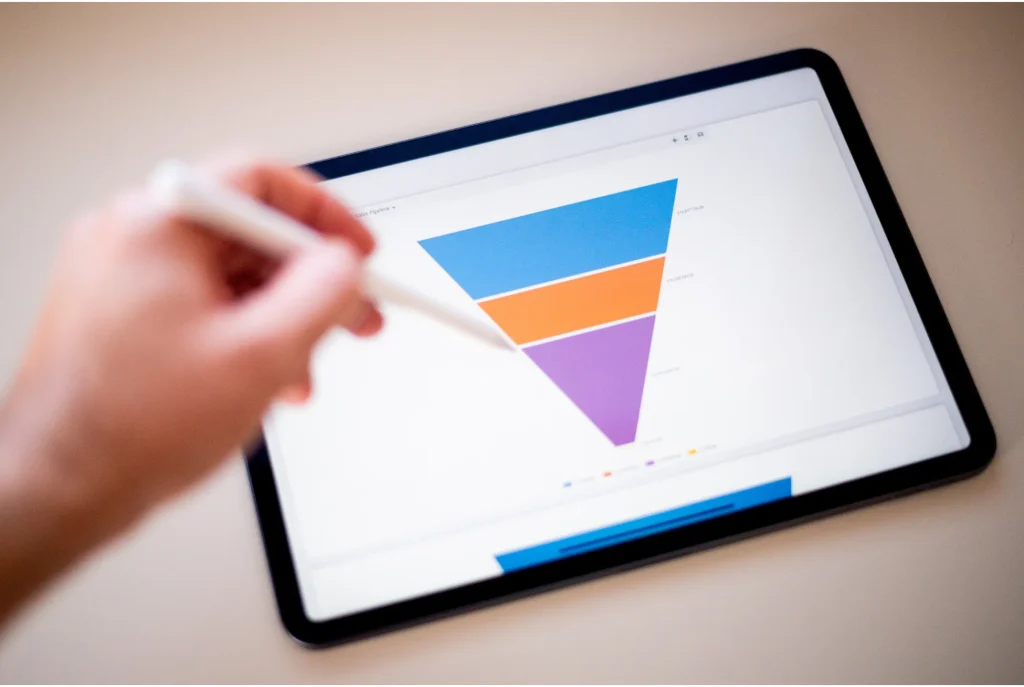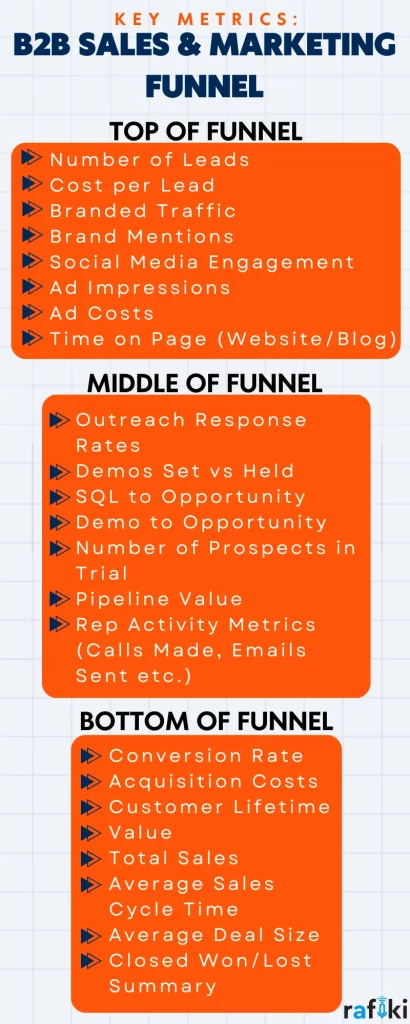Why Rafiki
Pricing


Pricing
Solutions

RevOps Leaders
Synchronize revenue generating functions

SDR Leaders
Get your team aligned and Coach your Reps 3x faster at scale

Sales Leaders
Unlock pipeline truth, drive confident forecasts

Imagine wading through a swamp, each step feeling heavier as you sink deeper. That's what navigating a B2B sales funnel without a clear strategy can feel like. You expend tremendous effort, yet progress remains elusive.
This guide equips you with the tools and knowledge to transform your funnel into a well-oiled machine or create one from scratch, propelling you towards consistent deal closures.
Without further ado, let's dive in!
The B2B sales funnel outlines the journey potential customers take, from initial awareness of your brand to conversion into paying clients. Unlike its B2C counterpart, the B2B funnel is typically longer and more complex, characterized by:
By recognizing these key differentiators, you can tailor your sales approach to fit the unique B2B landscape. From the buyer’s perspective, this is how the journey goes -

It’s important to compare the buying journey with your own perspective too as that is what will help you optimize. So, here's how the B2B sales funnel breaks down:
While this provides a general framework, the specific stages and activities within your B2B sales funnel might vary depending on your industry and target audience.
While both B2B and B2C sales aim to convert leads into customers, the journeys these leads take differ significantly. So here's a breakdown of the key distinctions between B2B and B2C sales funnels, and how understanding these differences can empower you to craft a winning B2B sales strategy:
B2B sales cycles tend to be significantly longer than their B2C counterparts. This is due to factors like:
Building trust is crucial in B2B sales, as purchases often involve long-term partnerships. Personalized communication, addressing specific needs, and demonstrating a deep understanding of the customer's industry and challenges become paramount.
B2B content marketing typically leans towards in-depth, informative content that addresses business challenges and showcases expertise. White papers, case studies, and industry reports are valuable tools for attracting and nurturing B2B leads at various stages of the funnel.
While B2C marketing often leverages social media and influencer marketing heavily, B2B strategies might prioritize industry publications, trade shows, and targeted online advertising to reach specific decision-makers.
Now that you grasp the essence of the B2B sales funnel and its significance, let's delve into the practical steps involved in constructing your own:
The foundation of any successful B2B sales funnel lies in understanding your ideal customer. Create a detailed ICP outlining the specific characteristics, needs, and pain points of your target audience. This empowers you to tailor content, messaging, and outreach strategies throughout the funnel.
Imagine the specific steps your ideal customer takes as they become aware of your brand, consider your offering, and ultimately make a purchase decision. This is your buyer's journey, and meticulously mapping it reveals valuable insights into the content and interactions your leads require at each stage.
Content plays a crucial role in attracting, engaging, and nurturing leads throughout the B2B sales funnel. However, a "one-size-fits-all" approach won't suffice. Instead, curate content specifically tailored to each stage of the buyer's journey.
Don't let leads fall through the cracks! Implement automated email sequences, personalized outreach, and targeted nurturing campaigns to keep your brand top-of-mind and guide prospects through the funnel.
Automation tools can streamline your B2B sales funnel by automating repetitive tasks, personalizing communications, and generating valuable insights into lead behavior. So consider incorporating such tools to enhance your funnel's efficiency and effectiveness.

From a sales reps’ perspective, here is what you can do to elevate your funnel and maximize lead conversion:
Analyzing sales calls with Rafiki's Smart Call Summary offers invaluable insights for improvement. Identify recurring objections, refine your value proposition based on customer pain points, and tailor your approach to resonate with different buyer personalities.
The B2B sales journey is a two-way street. Actively listen to understand your prospect's specific needs and challenges. By building genuine rapport and demonstrating empathy, you foster trust and position yourself as a trusted advisor, not just a salesperson.
Compelling narratives capture attention and make information memorable. Weave stories into your sales conversations to showcase the value proposition of your product or service in a relatable and impactful manner.
Anticipate potential objections and prepare clear, concise responses that address customer concerns directly. Ask Rafiki Anything is a feature that can be helpful here, allowing you to search past calls for common objections and analyze effective responses from top-performing reps.
The B2B landscape is dynamic, and so should your approach. Stay updated on industry trends, competitor offerings, and best practices in sales methodology. Additionally, invest in ongoing training and coaching to constantly refine your skills and remain a valuable asset in the ever-evolving B2B sales arena.
An effective B2B sales funnel isn't a solo act. It thrives on collaboration and shared responsibility between different teams within your organization. Here's how various roles contribute to a well-oiled funnel:
Open communication and data sharing between marketing and sales are crucial. This allows both teams to understand lead behavior at each stage, identify potential bottlenecks, and collaborate on strategies for improvement.
Rafiki's Smart CRM Sync can autofill prospect data in CRM based on prospect conversations, allowing all teams to have accurate data for different analyses and activities.
B2B sales teams often comprise members specializing in different stages of the funnel:
While each role has specific responsibilities, collaboration is key. SDRs can share insights from early interactions with leads to inform later stages. AEs can provide valuable feedback on content effectiveness and messaging tailored to address specific customer concerns.
The B2B sales funnel isn't just a marketing strategy; it's a roadmap to predictable revenue growth. By understanding its stages, crafting targeted content, and fostering collaboration across teams, you transform this funnel into a powerful engine propelling your business forward.
Optimize your B2B Sales Funnel
Keep in mind, continuous optimization and data-driven decision-making are the keys to unlocking your funnel's full potential. Embrace these principles, leverage tools like Rafiki to gain accurate data and insights and watch your B2B sales soar!